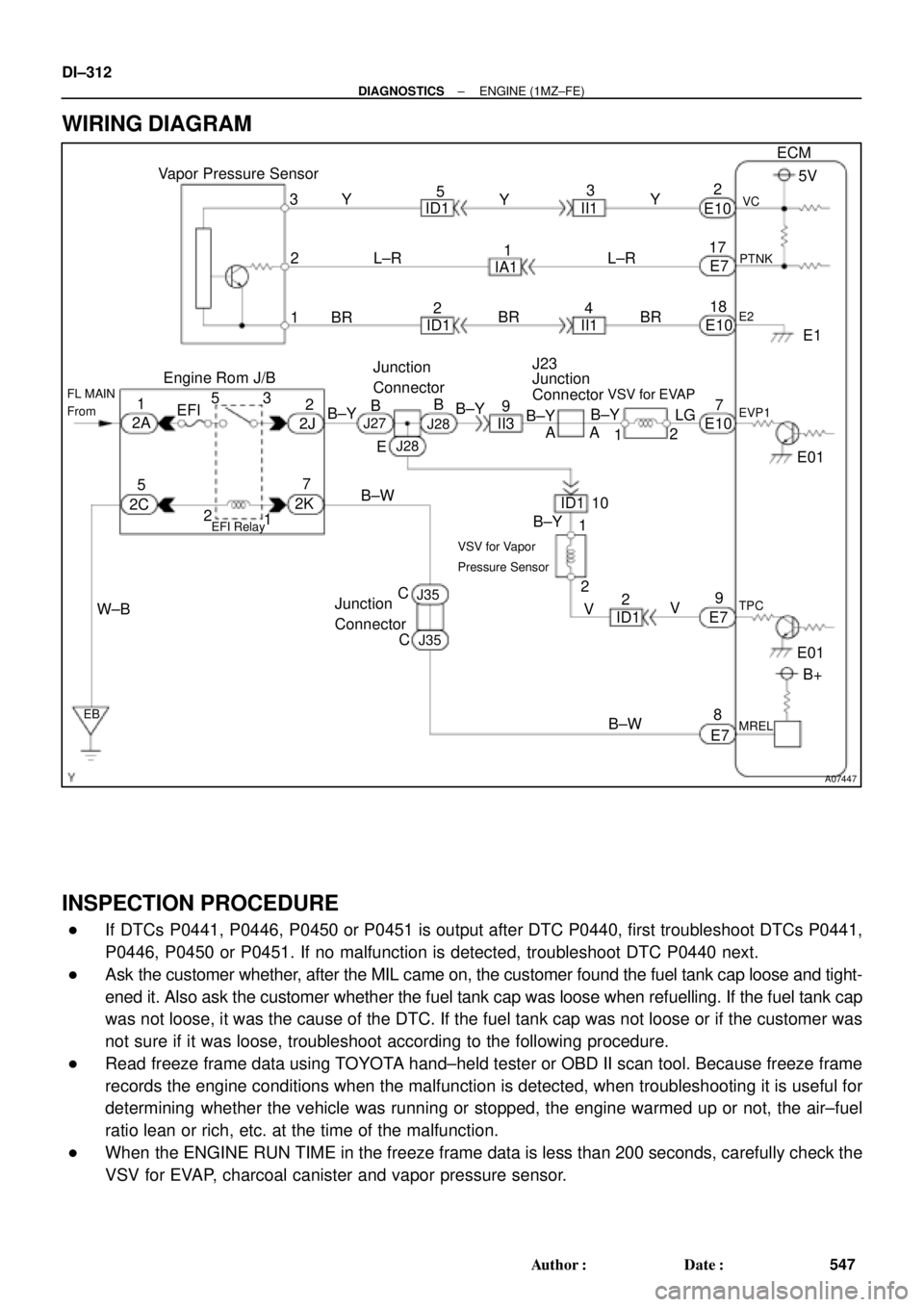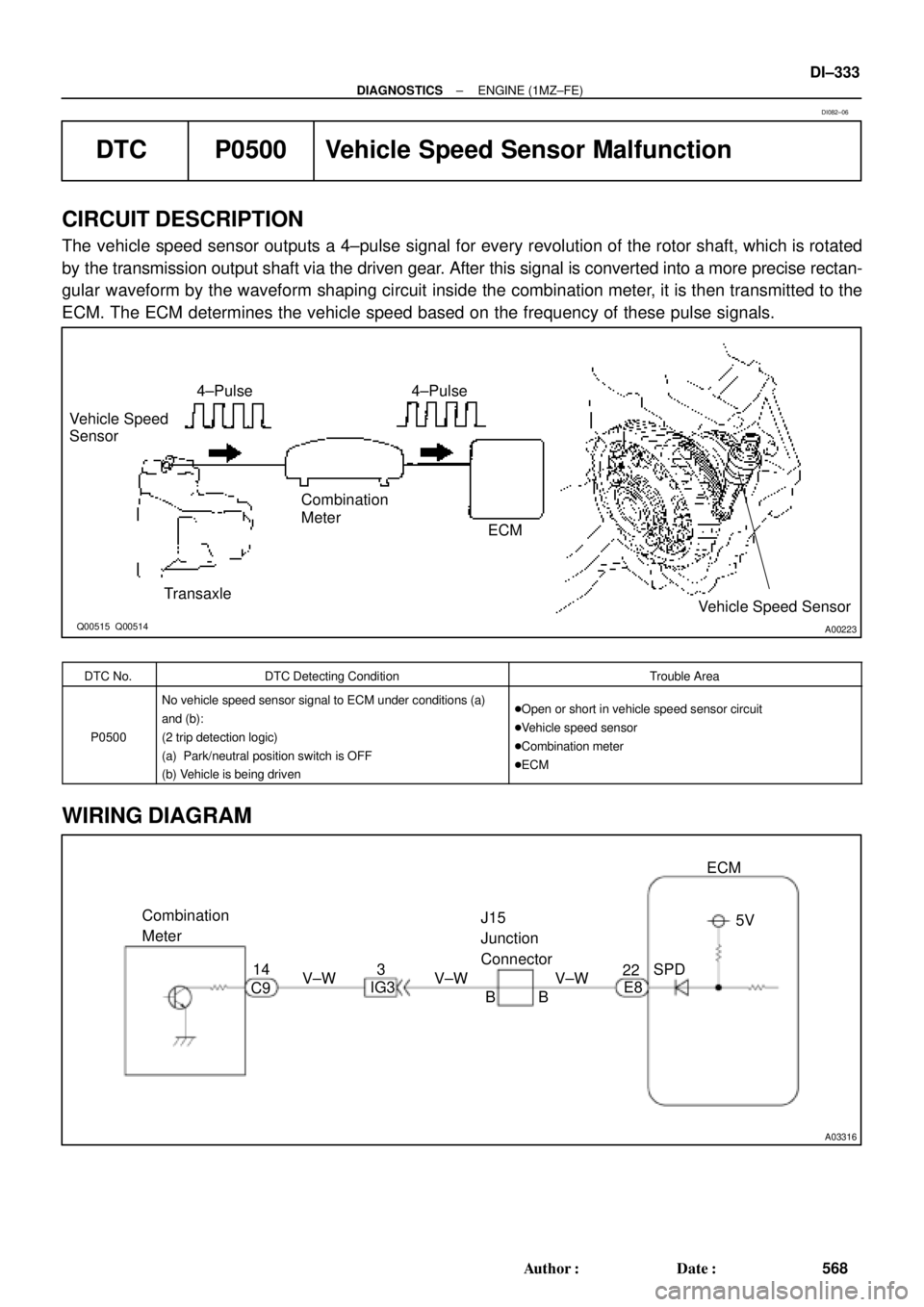Page 2707 of 4770

P25474
Camshaft Position Sensor
1
2
1
2B±W
B±RL
BR LECM
G22+
NE+
NE±
E2
E10
E10E11
2410
Crankshaft Position SensorB±R16
± DIAGNOSTICSENGINE (1MZ±FE)
DI±287
522 Author�: Date�:
DTC P0335 Crankshaft Position Sensor ºAº Circuit
Malfunction
CIRCUIT DESCRIPTION
Crankshaft position sensor (NE signal) consists of a signal plate and pickup coil.
The NE signal plate has 34 teeth and is mounted on the crankshaft. The NE signal sensor generates 34
signals for every engine revolution. The ECM detects the standard crankshaft angle based on the G22 sig-
nals, and the actual crankshaft angle and the engine speed by the NE signals.
DTC No.DTC Detecting ConditionTrouble Area
P0335
No crankshaft position sensor signal to ECM during cranking
(2 trip detection logic)�Open or short in crankshaft position sensor circuit
�Crankshaft position sensor
P0335No crankshaft position sensor signal to ECM with engine
speed 600 rpm or more (2 trip detection logic)
�Crankshaft osition sensor
�Starter
�ECM
WIRING DIAGRAM
INSPECTION PROCEDURE
HINT:
�Perform troubleshooting of DTC P0335 first. If no trouble is found, troubleshoot the following mechani-
cal systems.
�Read freeze frame data using TOYOTA hand±held tester or OBD II scan tool. because freeze frame
records the engine conditions when the malfunction is detected, when troubleshooting it is useful for
determining whether the vehicle was running or stopped, the engine warmed up or not, the air±fuel
ratio lean or rich, etc. at the time of the malfunction.
DI07U±06
Page 2710 of 4770

DI±290
± DIAGNOSTICSENGINE (1MZ±FE)
525 Author�: Date�:
DTC P0340 Camshaft Position Sensor Circuit
Malfunction
CIRCUIT DESCRIPTION
Camshaft position sensor (G22 signal) consist of a signal plate and pickup coil.
The G22 signal plate has one tooth, on its outer circumference and is mounted on the left bank camshafts.
When the camshafts rotate, the protrusion on the signal plate and the air gap on the pickup coil change,
causing fluctuations in the magnetic field and generating an electromotive force in the pickup coil.
The NE signal plate has 34 teeth and is mounted on the crankshaft. The NE signal sensor generates 34
signals for every engine revolution. The ECM detects the standard crankshaft angle based on the G22 signal
and the actual crankshaft angle and the engine speed by the NE signals.
DTC No.DTC Detecting ConditionTrouble Area
P0340
No camshaft position sensor signal to ECM during cranking
(2 trip detection logic)�Open or short in camshaft position sensor circuit
�Camshaft position sensor
P0340No camshaft position sensor signal to ECM with engine speed
600 rpm or more
�Camshaft osition sensor
�Starter
�ECM
WIRING DIAGRAM
Refer to DTC P0335 (Crankshaft Position Sensor ºAº Circuit Malfunction) on page DI±287 .
INSPECTION PROCEDURE
HINT:
Read freeze frame data using TOYOTA hand±held tester or OBD II scan tool. Because freeze frame records
the engine conditions when the malfunction is detected, when troubleshooting it is useful for determining
whether the vehicle was running or stopped, the engine warmed up or not, the air±fuel ratio lean or rich, etc.
at the time of the malfunction.
1 Check resistance of camshaft position sensor (See page IG±1).
Reference INSPECTION USING OSCILLOSCOPE
Refer to DTC P0335 on page DI±287.
NG Replace camshaft position sensor.
OK
DI07V±06
Page 2713 of 4770
A07446
J20
Junction
Connector
EFI Relay
2K2J
2C
BB±YJ27 J28
W±B
EB
9B±Y Y±G
AA1218
13 1
2
G±Y
BRECM
EGR
E01
EGLS5 V
E2 32
VC
5 V
THG
E7
2
1W±GY
BR18
8
MREL
B+ BR
EGR Gas Temp. Sensor
E10 E10
22
E11 E10E11
Engine Room J/B
2A2
7 1
53
1 5
EFI
VSV
for EGR
B±Y
Junction
Connector
B
2
B±Y
J35
J35C
C Junction
ConnectorB±W
B±W
B±W
EGR Valve
Position Sensor
II3From
FL MAIN
S06906
Vehicle Speed
70 ~ 90 km/h
(43 ~ 56 mph)
Idling
IG SW OFF(1)(2)(3)
(4)(5)
Warmed up 3 ~ 5 min. 3 min. 3 ~ 5 min. 2 min.Time
± DIAGNOSTICSENGINE (1MZ±FE)
DI±293
528 Author�: Date�:
WIRING DIAGRAM
SYSTEM CHECK DRIVING PATTERN
Page 2722 of 4770

DI±302
± DIAGNOSTICSENGINE (1MZ±FE)
537 Author�: Date�:
DTC P0402 Exhaust Gas Recirculation Flow
Excessive Detected (Ex CA Spec.)
CIRCUIT DESCRIPTION
Refer to DTC P0401 (Exhaust Gas Recirculation Flow Insufficient Detected) on page DI±292.
DTC No.DTC Detecting ConditionTrouble Area
P0402
When EGR cut±off, lift amount of EGR valve is
2.6 mm (0.1 in.) or more
(2 trip detection logic)
�EGR valve stuck open
�VSV for EGR open malfunction
�Short in VSV circuit for EGR
�Open or short in EGR valve position sensor circuit
�EGR valve position sensor
�ECM
See DTC P0401 (Exhaust Gas Recirculation Flow Insufficient Detected) on See page DI±292 for SYS-
TEM CHECK DRIVING PATTERN and WIRING DIAGRAM.
INSPECTION PROCEDURE
HINT:
Read freeze frame data using TOYOTA hand±held tester or OBD II scan tool. Because freeze frame records
the engine conditions when the malfunction is detected, when troubleshooting it is useful for determining
whether the vehicle was running or stopped, the engine warmed up or not, the air±fuel ratio lean or rich, etc.
at the time of the malfunction.
TOYOTA hand±held tester
1 Check connection and blockage of vacuum hose.
NG Repair or replace vacuum hose.
OK
2 Check VSV for EGR (See page DI±292, step 5).
OK Go to step 4.
NG
DI07X±06
Page 2732 of 4770

A07447
Vapor Pressure Sensor
2J2
9J23
B±Y
V
VSV for EVAP
LG
AA
2
1ECM
5V
VC
PTNK
E1
E2
EVP1
E01
E01
TPC
3
2
Engine Rom J/B
MREL VSV for Vapor
Pressure Sensor
II3
EB
B±W
W±BL±R Y
1BRE10
E7
E10
E72
17
18
7
9
E78
EFI Relay
IA1 L±RY Y
ID1 II13
5
1
II1 BR
BR
ID1 E10
B±Y
J28 J27
B
ID1 10
1
2
ID12 2A
7 1
2C5
2K 53
2
1 EFI
B±WFL MAIN
From
24
B+
J28E B±YB
B±Y
B±Y
V
J35
J35C
C Junction
Connector
Junction
ConnectorJunction
Connector DI±312
± DIAGNOSTICSENGINE (1MZ±FE)
547 Author�: Date�:
WIRING DIAGRAM
INSPECTION PROCEDURE
�If DTCs P0441, P0446, P0450 or P0451 is output after DTC P0440, first troubleshoot DTCs P0441,
P0446, P0450 or P0451. If no malfunction is detected, troubleshoot DTC P0440 next.
�Ask the customer whether, after the MIL came on, the customer found the fuel tank cap loose and tight-
ened it. Also ask the customer whether the fuel tank cap was loose when refuelling. If the fuel tank cap
was not loose, it was the cause of the DTC. If the fuel tank cap was not loose or if the customer was
not sure if it was loose, troubleshoot according to the following procedure.
�Read freeze frame data using TOYOTA hand±held tester or OBD II scan tool. Because freeze frame
records the engine conditions when the malfunction is detected, when troubleshooting it is useful for
determining whether the vehicle was running or stopped, the engine warmed up or not, the air±fuel
ratio lean or rich, etc. at the time of the malfunction.
�When the ENGINE RUN TIME in the freeze frame data is less than 200 seconds, carefully check the
VSV for EVAP, charcoal canister and vapor pressure sensor.
Page 2739 of 4770

± DIAGNOSTICSENGINE (1MZ±FE)
DI±319
554 Author�: Date�:
DTC No.DTC Detecting ConditionTrouble Area
Pressure in charcoal canister does not drop during purge con-
trol (2 trip detection logic)
P0441During purge cut±off, pressure in charcoal canister is very low
compared with atmospheric pressure
(2 trip detection logic)�Open or short in VSV circuit for EVAP
�Open or short in VSV circuit for vapor pressure sensor
�
Open or short in vaporpressure sensor circuit
When VSV for vapor pressure sensor is OFF, ECM judges that
there is no continuity between vapor pressure sensor and
charcoal canister (2 trip detection logic)
�Open or short in vapor pressure sensor circuit
�VSV for EVAP
�VSV for vapor pressure sensor
�Vapor pressure sensor
P0446
When VSV for vapor pressure sensor is ON, ECM judges that
there is no continuity between vapor pressure sensor and fuel
tank (2 trip detection logic)
Va o r ressure sensor
�Vacuum hose cracks, holed blocked, damaged or
disconnected ((1), (4), (5),(6) and (7) in fig. 1)
�Charcoal canister cracks, holed or damaged
F l t k fill h k l k d d dAfter purge cut off operates, pressure in charcoal canister is
maintained at atmospheric pressure
(2 trip detection logic)�Fuel tank over fill check valve cracked or damaged
WIRING DIAGRAM
Refer to DTC P0440 (Evaporative Emission Control System Malfunction) on page DI±311 for the WIRING
DIAGRAM.
INSPECTION PROCEDURE
HINT:
�If DTCs P0441, P0446, P0450 or P0451 is output after DTC P0440, first troubleshoot DTCs P0441,
P0446, P0450 or P0451. If no malfunction is detected, troubleshoot DTC P0440 next.
�Read freeze frame data using TOYOTA hand±held tester or OBD II scan tool. Because freeze frame
records the engine conditions when the malfunction is detected, when troubleshooting it is useful for
determining whether the vehicle was running or stopped, the engine warmed up or not, the air±fuel
ratio lean or rich, etc. at the time of the malfunction.
�When the ENGINE RUN TIME in the freeze frame data is less than 200 seconds, carefully check the
VSV for EVAP, charcoal canister and vapor pressure sensor.
TOYOTA hand±held tester
1 Check VSV connector for EVAP, VSV connector for vapor pressure sensor and
vapor pressure sensor connector for looseness and disconnection.
NG Repair or connect VSV or sensor connector.
OK
Page 2752 of 4770

DI±332
± DIAGNOSTICSENGINE (1MZ±FE)
567 Author�: Date�:
WIRING DIAGRAM
Refer to DTC P0440 (Evaporative Emission Control Malfunction) on page DI±311.
INSPECTION PROCEDURE
HINT:
�If DTCs P0441, P0446, P0450 or P0451 is output after DTC P0440, first troubleshoot DTCs P0441,
P0446 ,P0450 or P0451. If no malfunction is detected, troubleshoot DTC P0440 next.
�Read freeze frame data using TOYOTA hand±held tester or OBD II scan tool. Because freeze frame
records the engine conditions when the malfunction is detected, when troubleshooting it is useful for
determining whether the vehicle was running or stopped, the engine warmed up or not, the air±fuel
ratio lean or rich, etc. at the time of the malfunction.
�When the ENGINE RUN TIME in the freeze frame data is less than 200 seconds, carefully check the
VSV for EVAP, charcoal canister and vapor pressure sensor.
1 Check voltage between terminals VC and E2 of ECM connector
(See page DI±311, step 9).
NG Check and replace ECM (See page IN±31).
OK
2 Check voltage between terminals PTNK and E2 of ECM connectors
(See page DI±311, step 10).
OK Check and replace ECM (See page IN±31).
NG
3 Check for open and short in harness and connector between vapor pressure
sensor and ECM (See page IN±31).
NG Repair or replace harness or connector.
OK
Replace vapor pressure sensor.
Page 2753 of 4770

A00223
Vehicle Speed
Sensor
Combination
Meter
ECM
Transaxle4±Pulse 4±Pulse
Vehicle Speed Sensor
Q00515 Q00514
A03316
Combination
MeterJ15
Junction
Connector
14
C93
V±W V±W V±WECM
SPD5V
BBE8 22
IG3
± DIAGNOSTICSENGINE (1MZ±FE)
DI±333
568 Author�: Date�:
DTC P0500 Vehicle Speed Sensor Malfunction
CIRCUIT DESCRIPTION
The vehicle speed sensor outputs a 4±pulse signal for every revolution of the rotor shaft, which is rotated
by the transmission output shaft via the driven gear. After this signal is converted into a more precise rectan-
gular waveform by the waveform shaping circuit inside the combination meter, it is then transmitted to the
ECM. The ECM determines the vehicle speed based on the frequency of these pulse signals.
DTC No.DTC Detecting ConditionTrouble Area
P0500
No vehicle speed sensor signal to ECM under conditions (a)
and (b):
(2 trip detection logic)
(a) Park/neutral position switch is OFF
(b) Vehicle is being driven�Open or short in vehicle speed sensor circuit
�Vehicle speed sensor
�Combination meter
�ECM
WIRING DIAGRAM
DI082±06